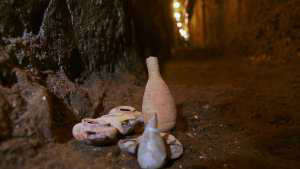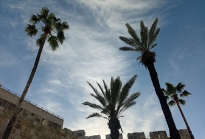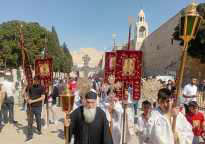
New finds from the 2000-year-old drainage channel
Splendor and Destruction in Jerusalem’s Ancient Drainage Channel
New finds from the 2000-year-old drainage channel in Jerusalem tells the city’s story in the days of the Second Temple from its prosperity until its decay and destruction
A complete glass vial, grape pips, two-thousand-year-old eggshells – and also complete ceramic lamps still with soot in them – all these were uncovered in a new excavation in the drainage channel running under Second Temple period Jerusalem’s main street. The excavation, managed by the Israel Antiquities Authority with funding from the City of David, reveals Jerusalem’s changing urban pulse in the last decades before the Temple’s destruction in 70 CE.
In the framework of this excavation, the channel that was Jerusalem’s main subterranean artery is being exposed.
This channel passed under, amongst other facilities, the colorful markets of Jerusalem at the foot of the Temple Mount, and along the entire length of the City of David.
“Into the channel’s mouth were swept the detritus of the life above Jerusalem's main street; where they remained preserved between the walls just as they were at the moment of the city’s destruction,” explains Dr. Ayala Zilberstein, Excavation Director on behalf of the Israel Antiquities Authority. “Small finds tell us a big story, from Jerusalem’s heyday of prosperity and splendor when its streets bustled with life, until the city’s ebbing moments during the rebellion against the Romans, and its total abandonment following the Temple and city’s destruction.”
According to Dr. Zilberstein, “Since most of these municipal channels were maintained and cleared regularly, to find layers of silt in the main drainage channel filling it to almost half its height, indicates a gradual neglect of city maintenance. And indeed, this very neglect and abandonment that we are now witness to here corresponds to the story of the process of Jerusalem’s destruction.”
In the upper layers of the alluvial soil the excavators discovered remains from the days of the city's destruction, including complete pottery lamps that are dated to the end of the Second Temple period. The soot preserved on their rims remains as a sign of the fire that once burned inside them. Some years ago, several meters south of the place where the oil lamps were uncovered, a
complete Roman sword still inside its leather scabbard was discovered, in an excavation led by Eli Shukron. The possibility is now being examined that, like the sword, the oil lamps were also held in the hands of the rebels who found a hiding place in this channel.
As the diggers dug ever deeper, they were further exposed to a multitude of finds that testify to Jerusalem’s splendor and wealth during the Second Temple period; the years during which the city hummed with never-ending activity. Already in the careful manual excavation executed by a skilled team, led by Nissim Mizrahi, complete vessels were found, including vials of perfume and expensive oils, mostly ceramic vials; and next to them, a delicate glass vial that was miraculously preserved almost without any damage.
The initial examination of the pottery and glass vessel assemblages, conducted by Dr. Yael Gorin-Rosen and Dr. Shulamit Terem, indicated an exceptionally rich and diverse concentration of vessel types, some quite rare. "Through this large variety of pots and dishes that accumulated in the drainage channel we encounter nearly the complete tableware set of Jerusalem’s residents. In contrast to the limited set of vessels generally found when excavating a single household kitchen, the channel assemblage is drawn from many houses, and from different streets in town, thus presenting us with examples of almost all wares the city’s merchants had to offer," explains Dr. Zilberstein.
In light of the archaeological potential inherent in the channel’s accumulated layers, all the bags of excavated dirt were saved, and then sent to the Sifting Project in Emek Zurim National Park. Along with extracting coins and colorful beads, the main contribution of the Sifting Project’s filtration work came from an unexpected direction, with the discoveries of food remains that helped researchers discover some of the secrets of the ancient Jewish kitchen: grape pips (seeds), kernels of grains, fish bones and even eggshells; all of which shed light on the menu of the Jerusalem’s residents when the city’s life was vibrant. The richness of the organic finds prompted a battery of diverse laboratory tests to detect remains not visible to the naked eye. Even in a preliminary examination conducted by Vitali Sterman and Dr. Yotam Asher from the Israel Antiquities Authority, it was possible to clearly discern the gap between those layers from the city's fully-active life, to the more recently accumulated layers. “The closer you get to the layers from the city’s later days – there is less and less evidence of human artifacts, and the picture begins to form of the demise of the city’s vitality,” adds Dr. Zilberstein. The important layers will be sampled using innovative methods.
Antiquities Authority Director. Eli Escusido sais: In these days, when the word ‘destruction’ takes on more relevance than usual, there is great value and it is important to look back into our past,
to remember where we came from and what we went through, to connect with our history, and thus gain a broader view of our life here in Israel. As part of the new excavation now taking place near the Western Wall and the City of David, a great wealth of finds reveals to us a magnificent city full of life, which by its nature emphasizes the magnitude of the destruction and engenders our understanding of what was lost."
Finds from the ancient drainage channel. Photo: Emil Aladjem, Israel Antiquities Authority.
 احدث فرقا
احدث فرقا
 اختبر الخلوة الروحية
اختبر الخلوة الروحية
 ذكرى البابا - زيارته لبيت لحم
ذكرى البابا - زيارته لبيت لحم
 النور المقدس في بيت لحم
النور المقدس في بيت لحم